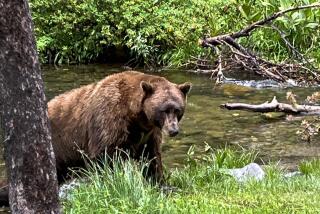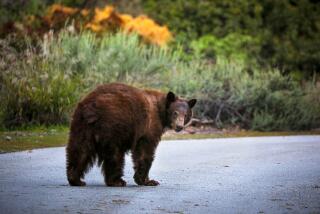Traipsing Through Alaska on the Trail of the Big Brown Bears
McNEIL RIVER, Alaska — Each summer, the falls at McNeil River turn into a mosh pit of bears.
Instead of thumping music, it’s the sound of salmon slapping their way up the falls at the McNeil River State Game Sanctuary that sends the bears into a fishing frenzy.
This summer, an exclusive group of 257 people was allowed into the 114,400-acre state sanctuary in an extraordinary opportunity to see close up one of the most feared predators on the planet.
“It is just awesome,” said Uleta Clark of Upper Kenai, whose name was selected by lottery to visit the sanctuary. “You aren’t going to see this anywhere else.”
In the peak weeks in July, the falls draw more brown bears, also called grizzlies, than anywhere else in the world. On a typical day, 30 to 40 bears gather to fish for salmon and fatten up for the winter. The record was 72 observed at one time in 1999.
The trail crosses tidal flats littered with mounds of bear scat, and past bear beds dug out in the beach or made from flattened marsh grasses. It goes along a rocky shore where mother bears doze in caves, nursing their cubs. It leads to a meadow crisscrossed with bear trails where the huge bruins nap in waist-high grasses, poking their heads up as sanctuary manager Larry Aumiller sings, “Hey bear, hey bear,” to alert them that humans are near.
McNeil is about 250 air miles southwest of Anchorage in a roadless area reachable by float plane near the lower shores of Cook Inlet. Most of the sanctuary guests, loaded with gear that includes camping equipment and thigh-high rubber boots, fly in from Homer, 100 miles away.
There were 1,500 applicants this year for the 257 permits. Groups of no more than 10 people are escorted into the sanctuary for four days of bear viewing between early June and late August.
“It’s like you are in a kaleidoscope of bears,” said Aumiller, who since 1976 has been leading small groups to the falls to watch the bears swat at salmon.
Nearly all brown bears in the United States live in Alaska, which has an estimated 30,000 to 40,000. Populations in Russia, once thought to rival those at McNeil, are proving smaller, Aumiller said.
The sanctuary was named for Charles H. McNeil, a LaCrosse, Wis., prospector who settled near Kamishak Bay in the early 1900s. He used the money from bear skins and skulls to help pay for grubstakes. When his claims expired, McNeil abandoned the property in the early 1930s.
Hunting brown bears at McNeil has been prohibited since 1955, even before Alaska became a state in 1959 and took control of the reserve.
The state designated McNeil as a sanctuary in 1967 and enlarged it in 1993. The sanctuary consists of a cookhouse, two outhouses, a wood-fired sauna and no-frills lodging for staff. Guests bring their own tents.
The bears don’t live entirely protected. Between one-fourth and one-third of them go outside McNeil boundaries where hunting is allowed. When a bear fails to return to the sanctuary, Aumiller presumes that it’s dead.
Aumiller, an agile man with an impish grin who still looks boyish at 60, is comfortable around bears -- so comfortable that when seated at the edge of a 10-foot-by-20-foot gravel viewing pad, he didn’t notice the 400-pound bear using the stairs five feet away.
“Oh, hello,” Aumiller said, glancing over his left shoulder at Kali, a 7-year-old female as she headed for the falls.
Aumiller estimates that he’s spent more than 12,000 hours watching bears during his summers at McNeil.
“Every day the scenario is unwritten. It’s not Disneyland. Because you don’t control it, you are accepting a small amount of risk. Something could happen,” he said.
Aumiller carries a 12-gauge shotgun loaded with bear slugs, but he’s never had to fire it. There have been 13 incidents in 29 years in which bears have acted aggressively, he said, but never when the 10-person groups are together. No bears or people have been hurt.
The McNeil experience is designed to minimize the danger in human-bear encounters. People in the sanctuary are neutral entities, Aumiller said. They don’t hunt the bears and don’t feed them; therefore, the bears find salmon much more interesting.
Sanctuary guides also give the bears plenty of warning when humans are near because bears hate surprises. If surprised, an aggressive bear might crouch, huff, flatten its ears, salivate or pop its jaws.
A 2003-2004 study found that McNeil bears are bigger than previously thought, with males weighing between 1,000 and 1,200 pounds and females about 600 pounds.
The bears pack on hundreds of pounds in the summer. A bear named Ears weighed 700 pounds when he was tagged and radio-collared in June 2003. When he went into his den several months later, he weighed 1,050 pounds.
Female bears easily can eat 75 pounds of fish a day, males even more.
“We did watch one bear catch 90 fish one day,” Aumiller said.
Fishing techniques vary among bears. Some perch for hours at the water’s edge, ready to pounce. Others stand braced in thigh-high water, looking for fins. Otis stole fish from other bears. One bear, dubbed “the diver,” held his head underwater with only his rump exposed, often coming up with a fish clenched between his teeth.
One bear did a running belly-flop, perhaps hoping to impact the fish like a percussion bomb. His efforts failed.
McDougall, at 1,200 pounds, arrived stylishly late one afternoon, swaggering onto the scene to recline on a large center rock. When ready for a bite, he walked to a prime spot, displaced another bear and plucked a salmon from the water, stripping its skin and shredding the meat.
Exertion over, the big bear returned to the rock for more rest.
Bill Barnes, 60, a physician from San Pablo, Calif., was making his fourth trip to McNeil. He said what drew him back to the sanctuary was his fascination with bear behavior.
“Bears are individuals, just like humans are,” he said.
Just look at McDougall, Barnes said. No other bears dared confront him.
“The bears have something that I wish humans had, and that’s learning when it’s important to fight and not to fight. I respect that,” he said.
More to Read
Sign up for The Wild
We’ll help you find the best places to hike, bike and run, as well as the perfect silent spots for meditation and yoga.
You may occasionally receive promotional content from the Los Angeles Times.






